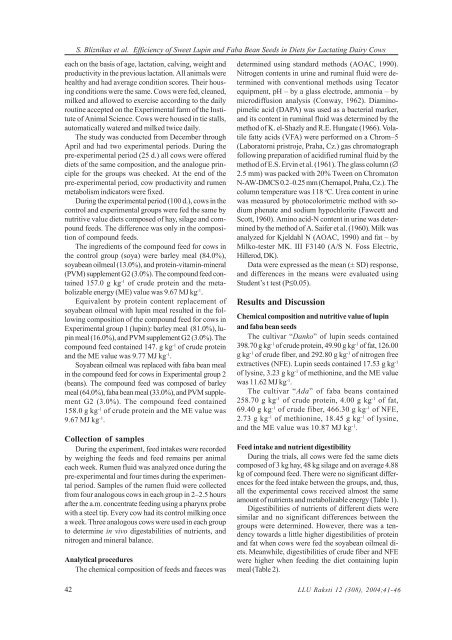saturs - Latvijas LauksaimniecÄ«bas universitÄte
saturs - Latvijas LauksaimniecÄ«bas universitÄte
saturs - Latvijas LauksaimniecÄ«bas universitÄte
- No tags were found...
Create successful ePaper yourself
Turn your PDF publications into a flip-book with our unique Google optimized e-Paper software.
S. Bliznikas et al. Efficiency of Sweet Lupin and Faba Bean Seeds in Diets for Lactating Dairy Cowseach on the basis of age, lactation, calving, weight andproductivity in the previous lactation. All animals werehealthy and had average condition scores. Their housingconditions were the same. Cows were fed, cleaned,milked and allowed to exercise according to the dailyroutine accepted on the Experimental farm of the Instituteof Animal Science. Cows were housed in tie stalls,automatically watered and milked twice daily.The study was conducted from December throughApril and had two experimental periods. During thepre-experimental period (25 d.) all cows were offereddiets of the same composition, and the analogue principlefor the groups was checked. At the end of thepre-experimental period, cow productivity and rumenmetabolism indicators were fixed.During the experimental period (100 d.), cows in thecontrol and experimental groups were fed the same bynutritive value diets composed of hay, silage and compoundfeeds. The difference was only in the compositionof compound feeds.The ingredients of the compound feed for cows inthe control group (soya) were barley meal (84.0%),soyabean oilmeal (13.0%), and protein-vitamin-mineral(PVM) supplement G2 (3.0%). The compound feed contained157.0 g kg -1 of crude protein and the metabolizableenergy (ME) value was 9.67 MJ kg -1 .Equivalent by protein content replacement ofsoyabean oilmeal with lupin meal resulted in the followingcomposition of the compound feed for cows inExperimental group 1 (lupin): barley meal (81.0%), lupinmeal (16.0%), and PVM supplement G2 (3.0%). Thecompound feed contained 147. g kg -1 of crude proteinand the ME value was 9.77 MJ kg -1 .Soyabean oilmeal was replaced with faba bean mealin the compound feed for cows in Experimental group 2(beans). The compound feed was composed of barleymeal (64.0%), faba bean meal (33.0%), and PVM supplementG2 (3.0%). The compound feed contained158.0 g kg -1 of crude protein and the ME value was9.67 MJ kg -1 .Collection of samplesDuring the experiment, feed intakes were recordedby weighing the feeds and feed remains per animaleach week. Rumen fluid was analyzed once during thepre-experimental and four times during the experimentalperiod. Samples of the rumen fluid were collectedfrom four analogous cows in each group in 2–2.5 hoursafter the a.m. concentrate feeding using a pharynx probewith a steel tip. Every cow had its control milking oncea week. Three analogous cows were used in each groupto determine in vivo digestabilities of nutrients, andnitrogen and mineral balance.Analytical proceduresThe chemical composition of feeds and faeces wasdetermined using standard methods (AOAC, 1990).Nitrogen contents in urine and ruminal fluid were determinedwith conventional methods using Tecatorequipment, pH – by a glass electrode, ammonia – bymicrodiffusion analysis (Conway, 1962). Diaminopimelicacid (DAPA) was used as a bacterial marker,and its content in ruminal fluid was determined by themethod of K. el-Shazly and R.E. Hungate (1966). Volatilefatty acids (VFA) were performed on a Chrom–5(Laboratorni pristroje, Praha, Cz.) gas chromatographfollowing preparation of acidified ruminal fluid by themethod of E.S. Ervin et al. (1961). The glass column (∅2.5 mm) was packed with 20% Tween on ChromatonN-AW-DMCS 0.2–0.25 mm (Chemapol, Praha, Cz.). Thecolumn temperature was 118 o C. Urea content in urinewas measured by photocolorimetric method with sodiumphenate and sodium hypochlorite (Fawcett andScott, 1960). Amino acid-N content in urine was determinedby the method of A. Saifer et al. (1960). Milk wasanalyzed for Kjeldahl N (AOAC, 1990) and fat – byMilko-tester MK. III F3140 (A/S N. Foss Electric,Hillerod, DK).Data were expressed as the mean (± SD) response,and differences in the means were evaluated usingStudent’s t test (P≤0.05).Results and DiscussionChemical composition and nutritive value of lupinand faba bean seedsThe cultivar “Danko” of lupin seeds contained398.70 g kg -1 of crude protein, 49.90 g kg -1 of fat, 126.00g kg -1 of crude fiber, and 292.80 g kg -1 of nitrogen freeextractives (NFE). Lupin seeds contained 17.53 g kg -1of lysine, 3.23 g kg -1 of methionine, and the ME valuewas 11.62 MJ kg -1 .The cultivar “Ada” of faba beans contained258.70 g kg -1 of crude protein, 4.00 g kg -1 of fat,69.40 g kg -1 of crude fiber, 466.30 g kg -1 of NFE,2.73 g kg -1 of methionine, 18.45 g kg -1 of lysine,and the ME value was 10.87 MJ kg -1 .Feed intake and nutrient digestibilityDuring the trials, all cows were fed the same dietscomposed of 3 kg hay, 48 kg silage and on average 4.88kg of compound feed. There were no significant differencesfor the feed intake between the groups, and, thus,all the experimental cows received almost the sameamount of nutrients and metabolizable energy (Table 1).Digestibilities of nutrients of different diets weresimilar and no significant differences between thegroups were determined. However, there was a tendencytowards a little higher digestibilities of proteinand fat when cows were fed the soyabean oilmeal diets.Meanwhile, digestibilities of crude fiber and NFEwere higher when feeding the diet containing lupinmeal (Table 2).42 LLU Raksti 12 (308), 2004; 41-46 1-18
















